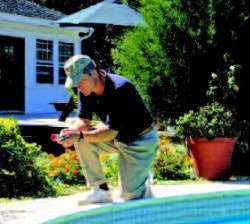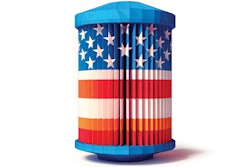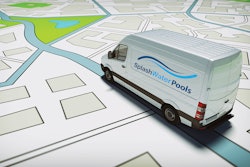
We tend to take safe and clean food, drinking water and indoor air for granted. But if it weren't for organizations like NSF International, a nonprofit, non-governmental standard-setting agency that also certifies products, our microwaves, toasters and blenders may not work as well as they do. Or, much worse, we might not be able to have any confidence in meat- and poultry-processing products, or wastewater treatment equipment might not appropriately sanitize the water we use in our homes every day.
Also in the interest of public safety, NSF International certifies many pool and spa products as part of the NSF Pool and Spa Equipment Program. This program encompasses voluntary standards, such as NSF/ANSI Standard 50, plus various standards criteria from ASTM, ASME and others. Pool products currently part of Standard 50 include filters, pumps, skimmers, drains, chemical feeders, multiport valves and many more. So it really shouldn't come as a surprise that water testing products are now being added to Standard 50. However, you may be wondering: How can methods as different as strips, titration kits and microprocessor-based meters be held to the same standard. Perhaps they won't, exactly. The standards for water testing products, which may be in place as early as late- 2006, are currently being developed. To learn more about the process, read on.
Two Cents Worth
Disagreements between regulatory officials, like public health inspectors, and water facility operators and maintenance staff prompted the NSF to expand Standard 50 to include water quality testing devices. "The disagreements hinged on important water-quality issues relating to whether a site needed to be closed due to the results of on-site water testing," says Richard Martin, business manager, municipal products, NSF – 50 & 61 for NSF International.
"Further, there was a need for all persons involved to be able to have confidence in the effectiveness or accuracy of products when used in pool and spa water conditions."
Fortunately, in developing NSF standards, all concerned parties have a voice. "We are different from others in terms of how we try to bring people together to work through issues," says Martin. "What we don't do is we don't allow the process to be steamrolled by just one group." Like all NSF-developed standards, NSF 50 represents a consensus of voting membership with a balance between manufacturers, users and regulatory authorities. So everyone from the CDC to watertesting product suppliers to commercial pool operators has a say in how the standard gets developed and what it will ultimately include.
At press time, the NSF Standard 50 Task Group on Water Quality Testing was determining the makeup of the challenge water, which is water with known parameters (pH, alkalinity, calcium hardness, etc.). Used to isolate variables, this challenge water will be used when the standards are developed. Once that's done, the task group will determine the degree of accuracy and precision that the various testing methods must meet. "I think the way things might shake out," says Martin, "is that there's going to be more than one level of performance requirements — one for super-precise stuff and one for a-little-less precise stuff — but the idea is to define some acceptable categories and ranges so the buyer knows what to expect, and it's not just a free-for-all crapshoot.
"The regulatory officials are interested in having a greater deal of precision for what they would use to open or shut down a pool. And then operators and end users are like, 'That's nice, I'm glad you can read down to that one-hundredth of a percent,' but they didn't feel that was necessary for their use to know give or take 0.01. If they know within 0.5, that would be great for their needs. They feel everything doesn't have to be a scanning electron microscope."
In The End
The ultimate goal in developing a program to evaluate water quality testing devices is to protect public health and safety and to eliminate disagreements between regulators and operators, says Martin. "This will enable all users to have greater confidence in their products and water quality. The scope of the program is wide, but the initial focus is on pH, free chlorine and total or combined chlorine — the critical public health and safety water chemistry parameters. Other common pool and spa water chemistry parameters, such as bromine, TDS and hardness, are being addressed, as well."
The manufacturers AQUA spoke with are pleased overall with the process so far. "Any time you can get a standardization and a comfort level where a well-respected, independent evaluation of these kits has been done and they rated them positively, then you can feel comfortable in the result that you're getting, as well," says Joe Sweazy, technical sales and service manager for Hach Company. "We're also encouraged by the fact that NSF is willing to work so closely together with manufacturers and other industry experts, including long-time veterans of the industry. And they haven't pretended to know everything about water chemistry and testing, so at this point, I would say our concerns are being addressed by us being part of the consultation process."
Lea Jaunakais, vice president of Industrial Test Systems, is also on board with the process. "I think it's very important that NSF has stepped up and become involved in the process and wants to create a standardization for testing for the consumer. I think it's a great idea, and it has needed to be done. I'm very excited to be a part of it."
Says Patricia Fitzgerald, vice president, marketing, at Taylor Technologies, "Liquid test kits (with both color-matching and titrimetric tests), test strips and portable instruments are a logical inclusion to NSF/ANSI 50, which already covers a wide array of pool and spa products. In asking for this guidance from NSF, public health officials noted that 'unsafe water chemistry goes hand in glove with recreational water incidents.' Taylor understands this and supports the creation of a sciencebased standard to evaluate the field tests pool and spa operators use to monitor water quality."
Richard LaMotte, vice president of marketing and sales for LaMotte Co., is also in favor of standards that will improve the quality of water testing products. "There are some things out there that really are not good chemistries and what happens is, because the industry has constantly driven manufacturers to lower costs, the next thing you know, you're saying, 'OK, rather than 10 standards for the comparitor, we'll get down to three or four.' As always, when you start beating on manufacturers to reduce costs, in any type of process, the product itself sooner or later will have some quality issues."
The Mark Of Approval
Once water testing products are part of NSF 50, states and municipalities will most likely require that testing products used to test public pools and spas be certified as meeting the requirements of NSF 50.
"Certification becomes a quality statement that my widget can do this," says Martin. "Because on the marketing side, people sometimes say things that are unsubstantiated and that of course drives regulatory officials crazy. So they're asking, 'What the heck does it really do.' This process helps folks that need to know what it can do to at least know certain minimal things. It's going to give some nice structure, predictability and hopefully some really high reliability to those users of the product that are making life-and-death decisions, like pool closings."
Since most, if not all, major test kit manufacturers will get their products certified, savvy service professionals, especially those that service commercial facilities, will want to advertise they use only NSF-certified test kits. Even if homeowners don't know the significance of the certification, service professionals who focus on residential pools and spas will benefit from using NSFcertified test kits. "It'll make a difference for them to be able to feel comfortable about the tests they're using," says Sweazy.
NPIRC Evaluates Test Kits And Manufacturers Respond
AS PART OF THEIR 2004-2005 PROTOCOLS, researchers at the National Pool Industry Research Center (NPIRC) at the California Polytechnic State University (Cal Poly) took a look at water testing products and, according to a NPIRC report, "the results strongly indicated significant differences among the test kits when measuring pH, total alkalinity and calcium hardness level concentrations." For example, Damian Kachlakev, Ph.D., the director of the NPIRC and an associate professor of civil engineering at Cal Poly, says one kit indicated a pool had calcium hardness of 150, while another indicated a hardness reading of 450.
The results have prompted researchers to do further tests on the water testing kits, including testing at a few other universities around the country. The results of these tests were not available at press time.
Meanwhile, test kit manufacturers have some concerns about the testing thus far, which they hope will be addressed in future protocols. According to a release from manufacturers Hach Company/AquaChek, LaMotte Company and Taylor Technologies, "As NPIRC moves into the next stage of its investigations, we hope the researchers will reevaluate their testing protocol so that errors and omissions will not continue to undermine their findings. In particular, we are concerned that two data points was not enough to make scientifically valid conclusions. We also want variables eliminated that cannot be accounted for in tabulating the results. For instance, a number of tests involve color matching. Do the researchers know for certain that the people performing the tests have the same ability to perceive colors?"
The release also indicates the manufacturers report observing poor laboratory technique during the ASTM determinations researchers made on "Test Kit Day" at Cal Poly, when the various testing products were put through their paces. They contend there were no controls in place to prevent this and that the reported results are therefore suspect.
"In terms of what could be done better, I think consistency is the key," says Joe Sweazy, technical sales and service manager for Hach Company. "They should really take great care to be sure the testing is consistent from test to test. An example of one of the things we think should be done is that samples of a known concentration, what we would call test standards, should be measured by the lab technicians as part of the testing to be sure that the method and the user are capable of getting an accurate result. In other words, as part of validation of their testing method, they would have a standard that is x ppm, and they would have to test that and make sure they're capable and that their method is capable of getting that and be able to establish some level of precision in getting that result."
Because the NPIRC researchers are interested in solving problems and not creating turmoil, says Kachlakev, they are listening to feedback and commentary from test kit suppliers and other industry experts.
While the research and results get sorted out, service professionals may be wondering, "What kit should I be using." or "Can I trust the kit I use." Keep in mind that millions of pools are kept clean and safe each year with the help of water testing products currently available. "I'm not one to say there's not room for improvement. Certainly there is," says Sweazy. "But the kits on the market have long been sufficient for the needs of our industry."







































